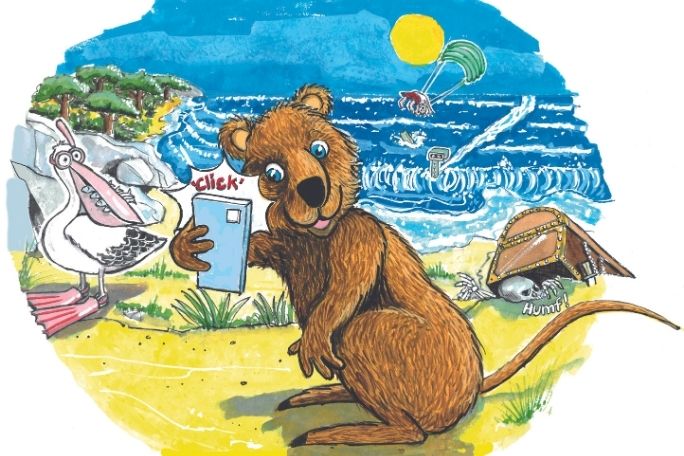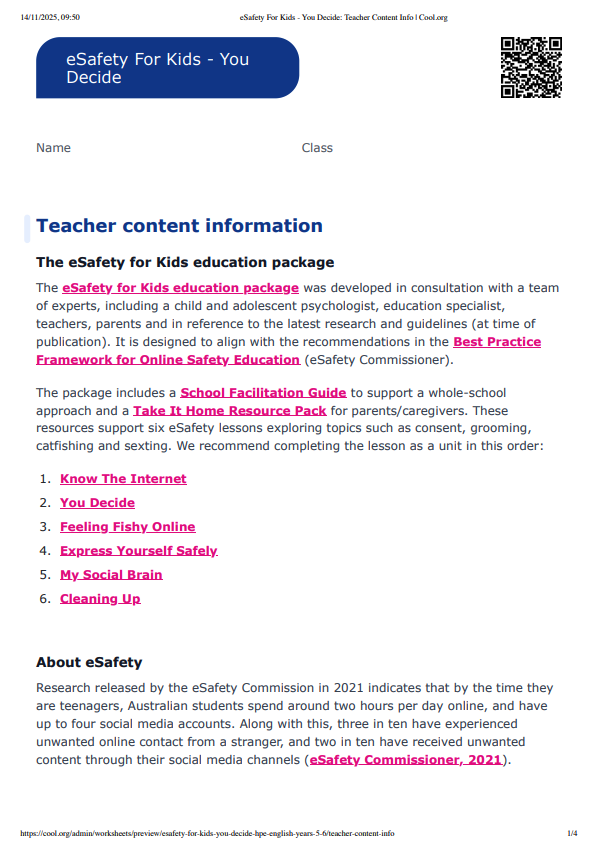Lesson summary
In this lesson, students will understand the importance of consent when requesting or sharing images online and know how to look for behaviours that try to change their mind.
Learning intentions:
Students will:
- understand the importance of consent when seeking to share content.
Success criteria:
Students can:
- create a list of safety roles for online interactions and activity.
Lesson guides and printables
Curriculum links
Select your curriculum from the options below.
Lesson details
Skills
This lesson is designed to build students’ competencies in the following skills:
- communication
- digital literacy
- initiative
- social skills
Curriculum Mapping
Australian Curriculum content descriptions:
Years 5 & 6 Health and Physical Education:
- Plan and practise strategies to promote health, safety and wellbeing (ACPPS054)
- Examine the influence of emotional responses on behaviour and relationships (ACPPS056)
- Recognise how media and important people in the community influence personal attitudes, beliefs, decisions and behaviours (ACPPS057)
Year 5 English:
- Plan, draft and publish imaginative, informative and persuasive print and multimodal texts, choosing text structures, language features, images and sound appropriate to purpose and audience (ACELY1704)
Year 6 English:
- Plan, draft and publish imaginative, informative and persuasive texts, choosing and experimenting with text structures, language features, images and digital resources appropriate to purpose and audience (ACELY1714)
- Participate in and contribute to discussions, clarifying and interrogating ideas, developing and supporting arguments, sharing and evaluating information, experiences and opinions (ACELY1709)
Syllabus outcomes: PHS3.12, SLS3.13, COS3.1, INS3.3, IRS3.11, DMS3.2, EN3-1A, EN3-2A
General capabilities: Literacy, Personal and Social Capability, Ethical Understanding, Information and Communication Technology (ICT) Capability
Relevant parts of Years 5 & 6 HPE achievement standards:
Students recognise the influence of emotions on behaviours and discuss factors that influence how people interact. They describe their own and others’ contributions to health, physical activity, safety and wellbeing.
Relevant parts of Years 5 & 6 Health and Physical Education achievement standards:
Students explain the influence of people and places on identities. They recognise the influence of emotions on behaviours and discuss factors that influence how people interact. They describe their own and others’ contributions to health, physical activity, safety and wellbeing.
Relevant parts of Year 5 English achievement standards:
Students create imaginative, informative and persuasive texts for different purposes and audiences
Relevant parts of Year 6 English achievement standards:
Students create detailed texts elaborating on key ideas for a range of purposes and audiences. They make presentations and contribute actively to class and group discussions, using a variety of strategies for effect.
This lesson is part of the wider unit of work eSafety For Kids
Time required: 60 mins
Level of teacher scaffolding: Medium – facilitate class discussion and support idea development
Resources Required
- Play-it-safe Rules For Online Worksheet – one digital or A3 copy per student
- Consent Continuum – digital or A3 colour copy
- Consent Vocabulary Worksheet – one copy per student
- Device to display visual content
- Glossary of Key Terms (optional)
- Handling Sensitive Topics and Issues Factsheet (digital copy)
- Student devices (optional)
- Super 10 Play-it-safe Rules For Kids And Grownups – digital or printed copies
Connected resources:
Additional Info
Although this can be completed as a standalone lesson, it will be most effective if completed within the sequence of the unit, as follows:
The eSafety for Kids education package was developed in consultation with a team of experts, including a child and adolescent psychologist, education specialist, teachers, parents and in reference to the latest research and guidelines (at time of publication). It is designed to align with the recommendations in the Best Practice Framework for Online Safety Education (eSafety Commissioner).
The images for this eSafety for Kids package are sourced from The Tweeting Galah book series and used with permission from Kim Maslin.



Welcome back!
Don't have an account yet?
Log in with:
Create your free Cool.org account.
Many of our resources are free, with an option to upgrade to Cool+ for premium content.
Already have an account?
Sign up with:
By signing up you accept Cool.org's Terms and Conditions(Opens in new tab) and Privacy Policy(Opens in new tab).